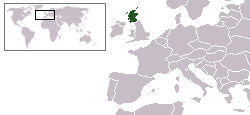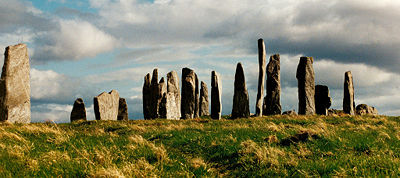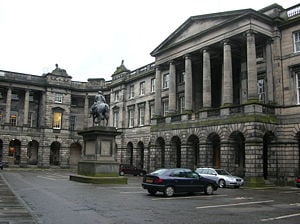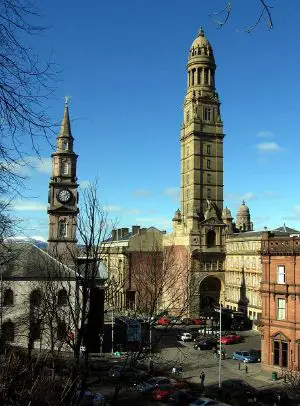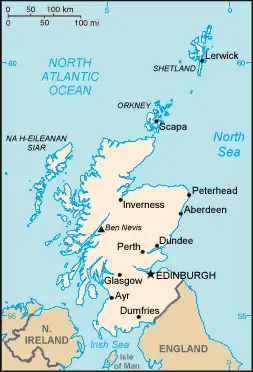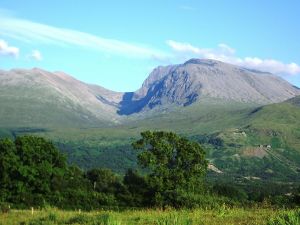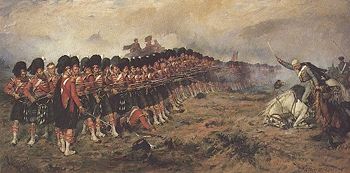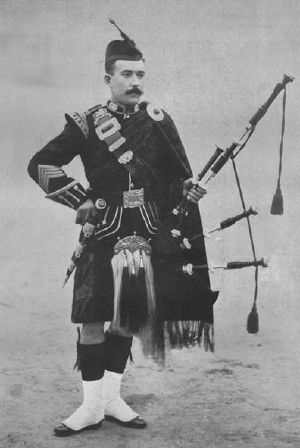Scotland
| Motto: Nemo me impune lacessit (Latin for "No one provokes me with impunity")1 | |
| Anthem: Multiple unofficial anthems | |
| Capital | Edinburgh |
| Largest city | Glasgow |
| Official language(s) | English, Scottish Gaelic2 |
| Government | Constitutional monarchy |
| - Queen of the UK | Queen Elizabeth II |
| - Prime Minister of the UK | Tony Blair MP |
| - First Minister | Jack McConnell MSP |
| Unification | |
| - by Kenneth I | 843 |
| Area | |
| - Total | 78,772 km² (2nd in UK) |
| 30,414 sq mi | |
| - Water (%) | 1.9 |
| Population | |
| - 20054 est. | 5,094,800 (2nd in UK) |
| - 2001 census | 5,062,011 |
| - Density | 64/km² (4th in UK) 167.5/sq mi |
| GDP (PPP) | 2002 estimate |
| - Total | US$130 billion |
| - Per capita | US$25,546 |
| Currency | Pound sterling (GBP)
|
| Time zone | GMT (UTC0) |
| - Summer (DST) | BST (UTC+1) |
| Internet TLD | .uk5 |
| Calling code | +44
|
| Patron Saint | St Andrew6 |
| 1 The Royal motto used in the rest of the United Kingdom is Dieu et mon droit (French for "God and my right") 2 Officially recognized languages: In addition to English (whose use is established by precedent), Scottish Gaelic has the status of being officially developed to become "an official language of Scotland commanding equal respect to the English language" [2] since 2005 Act. | |
Scotland (Scottish Gaelic Alba) is a nation in northwest Europe and one of the constituent countries[1] of the United Kingdom. It occupies the northern third of the island of Great Britain and shares a land border to the south with England. It is bounded by the North Sea to the east, the Atlantic Ocean to the north and west, and the North Channel and Irish Sea to the southwest. Apart from the mainland, Scotland consists of over 790 islands.[2]
Edinburgh, the nation's capital and second largest city, is one of Europe's largest financial centers.[3] Its largest city is Glasgow, the center of the Greater Glasgow conurbation which is home to approximately 40 percent of Scotland's population. Scottish waters consist of a large sector[4] of the North Atlantic and the North Sea, containing the largest oil reserves in the European Union.
The Kingdom of Scotland was an independent state until 1 May 1, 1707, when the Acts of Union resulted in a political union with the Kingdom of England to create the Kingdom of Great Britain. Scotland's legal, educational and judicial systems continue to be separate from those of England and Wales and Northern Ireland, and because of this it constitutes a discrete jurisdiction in public and in private international law.[5] Scots law, the Scottish education system and the Church of Scotland have been three cornerstones contributing to the continuation of Scottish culture and Scottish national identity since the Union. Scotland is not, however, a sovereign state and does not enjoy direct membership of either the United Nations or the European Union. Many Scots consider themselves to be both Scottish and British.
Etymology
The word Scot was borrowed from Latin and its use, to refer to Scotland, dates from at least the first half of the tenth century, when it first appeared in the Anglo-Saxon Chronicle as a reference to the Land of the Gaels, analogous to the Latin Scotia. Scottish kings adopted the title Basileus Scottorum or Rex Scottorum (meaning High King of the Gaels), and Rex Scotiae (King of Gael-land) some time in the eleventh century, likely influenced by the style Imperator Scottorum known to have been employed by Brian Boru in Ireland in 1005.
History
The history of Scotland began around in prehistoric times, when modern humans first began to inhabit Scotland after the end of the last ice age. Many artifacts remain from the Stone Age, Bronze Age, and Iron Age civilizations that existed in the country. The written history of Scotland began with the arrival of the Romans, who occupied England and Wales, leaving most of modern Scotland as unconquered Caledonia. Scotland was united under Kenneth MacAlpin in 843, and continued as a kingdom throughout the Middle Ages. The Union of the Crowns in 1707 finalized the transition to the United Kingdom, and the existence of modern Scotland.
Early Scotland
It is unknown whether Scotland was inhabited in palaeolithic times, as southern Britain was, but repeated glaciations, which covered the entire land-mass of modern Scotland, have destroyed any evidence of human habitation before the mesolithic period. It is believed that the first group(s) of hunter-gatherers arrived in Scotland around 11,000 years ago, as the ice sheet retreated after the last ice age. Groups of settlers began building the first permanent houses on Scottish soil around 9,500 years ago, and the first villages around 6,000 years ago. A site from this period is the well-preserved village of Skara Brae on the Mainland of Orkney. Neolithic habitation, burial and ritual sites are particularly common and well-preserved in the Northern and Western Isles, where a lack of trees led to most structures being constructed of local stone.
Callanish, on the West Side of the Isle of Lewis, in the Outer Hebrides is the location of the Callanish Stones, a cross-shaped setting of standing stones, one of the most spectacular megalithic monuments in Scotland, dating back to around 3,000 B.C.E.
The written history of Scotland largely began with the arrival of the Roman Empire in southern and central Great Britain, when the Romans occupied what is now England and Wales, administering it as a Roman province called Britannia. Part of southern Scotland was briefly indirectly controlled by Rome. To the north was Caledonia, territory not conquered by the Romans. The name represents that of a Pictish tribe, the Caledonii, one amongst several in the region, but perhaps the dominant tribe. The Roman Emperor Hadrian, realizing that the Caledonians would refuse to cohabitate with the Romans, and that the harsh terrain and highlands made its conquest costly and unprofitable for the Empire at large, decided instead on building a wall. Ruins of parts of this wall, bearing his name, still stand.
Pictland became dominated by the Pictish sub-kingdom of Fortriu. The Gaels of Dál Riata peopled Argyll. From this people came Cináed mac Ailpín (anglicized Kenneth MacAlpin), who united the Kingdom of Scotland in 843, when he became the King of the Picts and Gaels.
Medieval Scotland
In the following centuries, the kingdom of Scotland expanded to something closer to modern Scotland. The period was marked by comparatively good relations with the Wessex rulers of England, intense internal dynastic disunity, and, despite this, relatively successful expansionary policies. Sometime after an invasion of the Kingdom of Strathclyde by King Edmund of England in 945, the province was handed over to King Malcolm I. During the reign of King Indulf (954-962), the Scots captured the fortress later called Edinburgh, their first foothold in Lothian. The reign of Malcolm II saw fuller incorporation of these territories. The critical year was 1018, when Malcolm II defeated the Northumbrians at the Battle of Carham.
The Norman Conquest of England in 1066 initiated a chain of events which started to move the kingdom of Scotland away from its originally Gaelic cultural orientation. Malcolm III married Margaret the sister of Edgar Ætheling the deposed Anglo-Saxon claimant to the throne of England, who subsequently received some Scottish support. Margaret played a major role in reducing the influence of Celtic Christianity. When her youngest son David I later succeeded, Scotland gained something of its own gradual "Norman Conquest." Having previously become an important Anglo-Norman lord through marriage, David I was instrumental in introducing feudalism into Scotland, and in encouraging an influx of settlers from the "low countries" to the newly-founded burghs, to enhance trading links with mainland Europe and Scandinavia. By the late thirteenth century, scores of Norman and Anglo-Norman families had been granted Scottish lands. The first meetings of the Parliament of Scotland were convened during this period.
After the death of Margaret, known as the "Maid of Norway," last direct heir of Alexander III of Scotland, Scotland's nobility asked Edward I, King of England, to adjudicate between rival claimants to the vacant Scottish throne. John Balliol was chosen as king, having the strongest claim in feudal law, but Edward used the concessions he gained to undermine and then depose King John. The Scots resisted under the leadership of Sir William Wallace and Andrew de Moray in support of John Balliol, and later under that of Robert the Bruce. Bruce, crowned as King Robert I on March 25, 1306, won a decisive victory over the English at the Battle of Bannockburn in 1314. Warfare flared up again after his death during the Second War of Scottish Independence from 1332 to 1357 in which Edward Balliol unsuccessfully attempted to win back the throne from Bruce's heirs, with the support of the English king. Eventually, with the emergence of the Stewart dynasty in the 1370s, the situation in Scotland began to stabilise.
By the end of the Middle Ages, Scotland was showing a split into two cultural areas — the mainly Scots-speaking Lowlands, and the mainly Gaelic-speaking Highlands. Historically, the Lowlands were closer to mainstream European culture. By comparison, the clan system of the Highlands formed one of the region's more distinctive features, with a number of powerful clans remaining dominant until after the Acts of Union 1707.
Modern Scotland
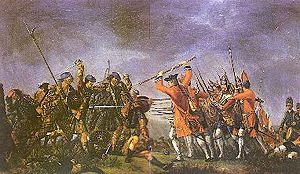
In 1603, James VI King of Scots inherited the throne of the Kingdom of England, and became also King James I of England. With the exception of a short period under The Protectorate, Scotland remained a separate state, but there was considerable conflict between the crown and the Covenanters over the form of church government. After the Glorious Revolution and the overthrow of the Roman Catholic James VII by William and Mary, Scotland briefly threatened to select a different Protestant monarch from England. In 1707, however, following English threats to end trade and free movement across the border, the Scots Parliament and the Parliament of England enacted the twin Acts of Union, which created the Kingdom of Great Britain.
Two major Jacobite risings launched from the Highlands of Scotland in 1715 and 1745 failed to remove the House of Hanover from the British throne.
Because of the geographical orientation of Scotland, and its strong reliance on trade routes by sea, the nation held close links in the south and east with the Baltic countries, and through Ireland with France and the continent of Europe. Following the Scottish Enlightenment and the Industrial Revolution, Scotland became one of the commercial, intellectual, and industrial powerhouses of Europe. After World War II, Scotland experienced an industrial decline which was particularly acute. Only in the latter part of the twentieth century did the country enjoy something of a cultural and economic renaissance. Factors which have contributed to this recovery include a resurgent financial services and electronics sector, the proceeds of North Sea oil and gas, and the devolved Scottish Parliament, established by the UK government under the Scotland Act 1998.
Politics
As one of the constituent countries of the United Kingdom, the head of state in Scotland is the British monarch, since 1952, Queen Elizabeth II. Constitutionally the United Kingdom is a unitary state with one sovereign parliament and government.
Political debate in Scotland revolved around the constitution, and this dominated the Scottish political scene in the latter half of the twentieth century. After devolution occurred, debate continued over whether the Scottish Parliament should accrue additional powers (for example over fiscal policy), or seek to obtain full independence with full sovereign powers (either through independence, a federal United Kingdom or a confederal arrangement).
Under a system of devolution (or Home Rule) adopted after Scottish and Welsh referendums on devolution proposals in 1997, most of the constituent countries within the United Kingdom were given limited self-government, (except England). The British Parliament in Westminster retains the ability to amend, change, broaden or abolish the devolved governmental systems at will. As such the Scottish Parliament is not sovereign. However, it is thought unlikely that any British parliament would unilaterally abolish a home rule parliament and government without consultation via a referendum with the voters of the constituent country.
Executive power in the United Kingdom is vested in the Queen-in-Council, while legislative power is vested in the Queen-in-Parliament (the Crown and the Parliament of the United Kingdom at Westminster in London). Under devolution, executive and legislative powers in certain areas have been constitutionally delegated to the Scottish Executive and the Scottish Parliament at Holyrood in Edinburgh respectively. The United Kingdom Parliament retains active power over Scotland's taxes, social security system, the military, international relations, broadcasting, and some other areas explicitly specified in the Scotland Act 1998. The Scottish Parliament has legislative authority for all other areas relating to Scotland, and has limited power to vary income tax, but has never exercised this power. The Scottish Parliament can refer devolved matters back to Westminster to be considered as part of United Kingdom-wide legislation under the Sewel motion system if United Kingdom-wide legislation is considered to be more appropriate for certain issues. The programs of legislation enacted by the Scottish Parliament have seen a divergence in the provision of social services compared to the rest of the United Kingdom. For instance, the costs of a university education, and care services for the elderly are free at point of use in Scotland, while fees are paid in the rest of the UK. Scotland was the first country in the UK to ban smoking in public places.[6]
The Scottish Parliament is a unicameral legislature, comprised of 129 elected members. The Queen appoints one of the members of the Parliament, on the nomination of the Parliament, to be First Minister. Other Ministers are also appointed by the Queen on the nomination of the Parliament and together with the First Minister they make up Scottish Executive. Scotland is also represented in the British House of Commons by 59 elected members.
Law
Scots law is the legal system of Scotland and has a basis in Roman law, combining features of both uncodified civil law dating back to the Corpus Juris Civilis and common law with medieval sources. The terms of the Treaty of Union with England in 1707, guaranteed the continued existence of a separate legal system in Scotland from that of England and Wales. Formerly, there were several regional law systems in Scotland, one of which was the use of Udal Law in Orkney and Shetland, based on Old Norse Law, which for the most part was abolished in 1611. Various systems based on common Celtic or Brehon Laws also survived in the Highlands until the 1800s.
Scots law provides for three types of courts: civil, criminal, and heraldic courts. The supreme civil court is the Court of Session, although civil appeals can be taken to the House of Lords in London, and the High Court of Justiciary is the supreme criminal court. Both courts are housed at Parliament House in Edinburgh, the home of the pre-Union Parliament of Scotland. The sheriff court is the main criminal and civil court. There are 49 sheriff courts throughout the country.[7] District courts were introduced in 1975 for minor offences. The Court of the Lord Lyon regulates heraldry in Scotland.
Scots law is also unique in that it allows three verdicts in criminal cases, including the controversial "not proven" verdict.[8][9]
Geography
Scotland comprises the northern third of the island of Great Britain, off the coast of north west Europe. The total land mass is around 78,772 square kilometers (30,414 square miles). Scotland's only land border is with England, and runs for 96 kilometers (60 miles) between the River Tweed on the east coast and the Solway Firth in the west. The island of Ireland lies around 30 kilometers (20 miles) off the south west tip of Scotland, Norway is around 400 kilometres (250 miles) to the north east, and the Faroes and Iceland lie to the north. Scotland lies between the Atlantic Ocean and the North Sea.
The country consists of a mainland area plus several island groups. The mainland can be divided into three areas: the Highlands in the north; the Central Belt, and the Southern Uplands in the south. The Highlands are generally mountainous and are bisected by the Great Glen. The highest mountains in the British Isles are found here, including Ben Nevis, the highest peak at 1,344 meters (4,409 feet). The Central Belt of Scotland is generally flat and is where most of the population reside. This area is divided into the West Coast, which contains the areas around Glasgow; and the East Coast which includes the areas around the capital, Edinburgh. The Southern Uplands are a range of hills and mountains almost 200 kilometers (125 miles) long, stretching from Stranraer by the Irish Sea to East Lothian and the North Sea.
Scotland has over 790 islands, divided into four main groups: Shetland, Orkney, and the Hebrides, divided into the Inner Hebrides and Outer Hebrides. The Firth of Clyde and the Firth of Forth also contain many islands. St. Kilda is the most remote of all the inhabitable Scottish islands, being over 160 kilometers (100 miles) from the mainland. Almost all the islands surrounding Scotland, no matter how small or remote, were formerly inhabited, as is shown by archaeological and documentary evidence. In general only the more accessible and larger islands retain human populations (though these are in some cases very small). Access to several islands in the Northern and Western groups was made easier in the course of the twentieth century by the construction of bridges or causeways installed for strategic reasons during the Second World War between several small islands on the east side of Scapa Flow in Orkney. Plans, some controversial, for more links between islands continue to be drawn up.
Climate
The climate of Scotland is temperate and oceanic, and tends to be very changeable. It is warmed by the Gulf Stream from the Atlantic, and as such is much warmer than areas on similar latitudes, for example Oslo, Norway. However, temperatures are generally lower than in the rest of the UK, with the coldest ever UK temperature of -27.2°C (-16.96°F) recorded at Braemar in the Grampian Mountains, on February 11, 1895 and January 10, 1982, and also at Altnaharra, Highland, on December 30, 1995. [10] Winter maximums average 6°C (42.8°F) in the lowlands, with summer maximums averaging 18°C (64.4°F). The highest temperature recorded was 32.9°C (91.22°F) at Greycrook, Scottish Borders on August 9, 2003. [11]
In general, the west of Scotland is usually warmer than the east, due to the influence of the Atlantic ocean currents, and the colder surface temperatures of the North Sea. Tiree, in the Inner Hebrides, is the sunniest place in the country: it had 300 days of sunshine in 1975. Rainfall varies widely across Scotland. The western highlands of Scotland are the wettest place, with annual rainfall exceeding 3,000 mm (120 inches).[11] In comparison, much of lowland Scotland receives less than 800 mm (31 inches) annually.[11] Heavy snowfall is not common in the lowlands, but becomes more common with altitude. Braemar experiences an average of 59 snow days per year,[12] while coastal areas have an average of less than 10 days.[11]
Economy
The Scottish economy is closely linked with that of the rest of Europe and the wider Western world, with a heavy emphasis on exporting. It is essentially a market economy with some government intervention. After the Industrial Revolution, the Scottish economy concentrated on heavy industry, dominated by the shipbuilding, coal mining and steel industries. Scotland was an integral component of the British Empire which allowed the Scottish economy to export its output throughout the world.
Heavy industry declined, however, in the latter part of the twentieth century, leading to a remarkable shift in the economy of Scotland towards a technology and service sector-based economy. The 1980s saw an economic boom in the "Silicon Glen" corridor between Glasgow and Edinburgh, with many large technology firms relocating to Scotland. The discovery of North Sea oil in the 1970s also helped to transform the Scottish economy.
Edinburgh is the financial services centre of Scotland and the sixth largest financial center in Europe,[13] with many large finance firms based there, including the Royal Bank of Scotland (the second largest bank in Europe).
Glasgow is Scotland's leading seaport and is the fourth largest manufacturing center in the UK, accounting for well over 60 percent of Scotland's manufactured exports. Shipbuilding, although significantly diminished from its heights in the early twentieth century, still forms a large part of the city's manufacturing base. The city also has Scotland's largest and most economically important commerce and retail district. Glasgow is also one of Europe's top 20 financial centers and is home to many of the UK's leading companies.
Aberdeen is the center of the North Sea oil industry. Other important industries include textile production, chemicals, distilling, brewing, commercial fishing and tourism.
Only about one quarter of the land is under cultivation (principally in cereals and vegetables), but sheep farming is important in the less arable highland and island regions. Most land is concentrated in relatively few hands (some 350 people own about half the land). As a result, in 2003, the Scottish Parliament passed a Land Reform Act that empowered tenant farmers and local communities to purchase land even if the landlord did not want to sell.
In 2004, total Scottish exports (excluding intra-UK trade) were provisionally estimated to be £16.7 billion, of which 73 percent (£12.19 billion) were attributable to manufacturing. The largest export products for Scotland are niche products such as whisky, electronics, and financial services. The largest markets were the United States, Germany, and The Netherlands.[14] In 2002, the Gross Domestic Product (GDP) of Scotland was just over £74 billion ($130 billion), giving a per capita GDP of £14,651 ($25,546).[15]
Although the Bank of England is the central bank for the UK, three Scottish clearing banks still issue their own Sterling banknotes: the Bank of Scotland; the Royal Bank of Scotland; and the Clydesdale Bank. These notes have no status as legal tender in England, Wales, or Northern Ireland, although they are fungible with the Bank of England banknotes. Despite this, Scottish-issued notes are often refused in England and they are not always accepted by banks and exchange bureaus outside the UK. The Royal Bank of Scotland still produces a £1 note, unique among British banks. The current value of the Scottish banknotes in circulation is around £2.5 billion.
Military
Although Scotland has a long military tradition that predates the Act of Union with England, its armed forces now form part of the British Armed Forces.
Due to their topography and perceived remoteness, parts of Scotland have housed many sensitive defense establishments, with mixed public feelings. Between 1960 and 1991, the Holy Loch was a base for the U.S. fleet of Polaris ballistic missile submarines. Today, HMNB Clyde, only 25 miles (40 km) west of Glasgow, is the base for the four Trident missile-armed Vanguard class ballistic missile submarines that comprise the the UK's nuclear deterrent. HMS Caledonia at Rosyth in Fife is the support base for navy operations in Scotland and also serves as the Naval Regional Office. The Royal Navy's submarine nuclear reactor development establishment, is located at Dounreay, which was also the site of the UK's fast breeder nuclear reactor program. HMS Gannet is a search and rescue station based at Prestwick Airport in Ayrshire and operates three Seaking Mk 5 helicopters. RM Condor at Arbroath, Angus is home to 45 Commando, Royal Marines.
Scotland is also home to RAF Lossiemouth, the Royal Air Force's primary base for the Tornado GR4 strike aircraft, RAF Kinloss, home to the Hawker-Siddeley Nimrod maritime patrol aircraft, and RAF Leuchars, the most northerly air defence fighter base in the United Kingdom. The only open air live depleted uranium weapons test range in the British Isles is located near Dundrennan.[16] As a result, over 7000 radioactive munitions lie on the seabed of the Solway Firth.[17] This has led to many environmental concerns.[18] The proportionally large amount of military bases in Scotland, when compared to other parts of the UK, has led some to use the euphemism "Fortress Scotland".[19] In 2004, the Ministry of Defence land holdings in Scotland (owned, leased, or with legal rights) was 91,200 hectares representing around 38 percent of that of the UK.[20]
Demographics
The population of Scotland in the 2001 census was 5,062,011. This has risen to 5,094,800 according to July 2005 estimates.[21] This would make Scotland the 112th largest country by population if it were a sovereign nation-state. Although Edinburgh is the capital of Scotland it is not the largest city; Scotland's largest city, with a population of 629,501, is Glasgow. The highest concentration of population in Scotland is in the areas surrounding Glasgow with approximately 2.2 million people living in west central Scotland centred on the Greater Glasgow urban conurbation.[22][23] Scotland has the highest proportion of redheads of any country worldwide with around 13% of the population having naturally red hair. A further 40% of Scots carry the Mc1r variant gene which results in red hair.
Due to immigration since World War II, Glasgow, Edinburgh, and Dundee have significant Asian and Scottish Asian populations.[24] Since the recent enlargement of the European Union there has been an increased number of people from Central and Eastern Europe moving to Scotland. For example, in 2005 Aleksander Dietkow, Consul General of Poland, estimates that between 40,000 and 50,000 Poles lived in Scotland.[25] As of 2003, there are 16,315 Chinese people in Scotland and 18.2 percent of international students at Scottish universities come from China, making them the largest international student group in Scotland.[26]
Languages
Since the United Kingdom lacks a codified constitution, there is no official language. However, Scotland has three officially recognised languages: English, Scottish Gaelic, and Scots. De facto English is the main language, and almost all Scots speak Scottish Standard English.
During the twentieth century the number of native speakers of Gaelic, a Celtic language similar to Irish, declined from around 5 percent to just 1 percent of the population, almost always on a fully bilingual basis with English.[27] Gaelic is mostly spoken in the Western Isles, where the local council uses the Gaelic name - Comhairle nan Eilean Siar ("Council of the Western Isles"). The General Register Office for Scotland estimates that 30 percent of the population are fluent in Scots, a West Germanic sister language to English.
Scots and Gaelic were recognised under the European Charter for Regional or Minority Languages ratified by the UK in 2001, and the Scottish Executive is committed, based on the UK's undertakings, to providing support for both[28] Under the Gaelic Language (Scotland) Act 2005 which was passed by the Scottish Parliament to provide a statutory basis for a limited range of Gaelic language service provision, English and Gaelic receive "equal respect" but do not have equal legal status.[29] State support for Scots is slowly growing with the Scottish Executive providing some funding to various Scots language projects and bodies, including the Dictionary of the Scots Language.
It is possible that there is around the same number of speakers of languages like Polish, Slovak, and Lithuanian in Scotland as there are Scottish Gaelic speakers. Latin is still currently in use for some legal terms within the Scottish Justice System.
Religion
The Church of Scotland, also sometimes popularly known as The Kirk, is the national church and has a Presbyterian system of church government. It is not subject to state control nor is it "established" as is the Church of England within England. It was formally recognised as independent of the UK Parliament by the Church of Scotland Act 1921, settling centuries of dispute between church and state over jurisdiction in spiritual matters.
The Scottish Reformation, initiated in 1560 and led by John Knox, was Calvinist, and throughout the seventeenth and eighteenth centuries, the Church of Scotland maintained this theology and kept a tight control over the morality of much of the population. The Church had a significant influence on the cultural development of Scotland in early modern times. Other Protestant denominations in Scotland include the Free Church of Scotland, an off-shoot from the Church of Scotland adhering to a more conservative style of Calvinism, the Scottish Episcopal Church, which forms part of the Anglican Communion, the Methodists, the Congregationalists, and the Church of Jesus Christ of Latter-day Saints.
Roman Catholicism in Scotland survived the Reformation, especially on islands like Uist and Barra, despite the suppression of the sixteenth to the late eighteenth centuries. Roman Catholicism was strengthened particularly in the west of Scotland during the nineteenth century by immigration from Ireland. This continued for much of the twentieth century, during which significant numbers of Catholics from Italy and Poland also migrated to Scotland. Much of Scotland (particularly the West Central Belt around Glasgow) has experienced problems caused by sectarianism, particularly football rivalry between the traditionally Roman Catholic team, Celtic, and the traditionally Protestant team, Rangers.
Islam is the largest non-Christian religion in Scotland (estimated population, 50,000) despite accounting for less than 1 percent of the population.[30] There are also significant Jewish and Sikh communities, especially in Glasgow. At 28 percent of the population, Scotland has a relatively high proportion of persons who regard themselves as belonging to "no religion." Indeed, this was the second most common response in the 2001 census.[30]
Education
The education system in Scotland is distinct from the rest of the United Kingdom and was the first country since Sparta in classical Greece to implement a system of general public education. The early roots were in the Education Act of 1496, which first introduced compulsory education for the eldest sons of nobles. Then, in 1561, the principle of general public education was set with the Reformation establishment of the national Kirk which set out a national program for spiritual reform, including a school in every parish. Education finally came under the control of the state rather than the Church and became compulsory for all children from the implementation of the Education Act of 1872 onwards. As a result, for over two hundred years Scotland had a higher percentage of its population educated at primary, secondary, and tertiary levels than any other country in Europe. The differences in education have manifested themselves in different ways, but most noticeably in the number of Scots who went on to become leaders in their fields and at the forefront of innovation and discovery leading to many Scottish inventions during the eighteenth and nineteenth centuries.
Today, children in Scotland sit Standard Grade exams at the age of 15 or 16, sometimes earlier, for up to eight subjects including compulsory exams in English, mathematics, a foreign language, a science subject and a social subject. Each school may vary these compulsory combinations. The school leaving age is 16, after which students may choose to remain at school and study for Access, Intermediate, or Higher Grade and Advanced Higher exams. A small number of students at certain private, independent schools may follow the English system and study towards GCSEs instead of Standard Grades, and towards A-Level and AS-Levels instead of Higher Grade and Advanced Higher exams.
The Scottish Executive funds over forty further and higher education colleges where students can study for more vocational qualifications; degree-entry qualifications such as diplomas; and specialist courses in the arts or agriculture. Scotland has 13 universities and one university college, including the four ancient universities of Aberdeen, Edinburgh, Glasgow, and St Andrews founded during the medieval period. Bachelor's degrees at Scottish universities are bestowed after four years of study, with the option to graduate with an "ordinary degree" after three years or continue with the fourth year of study to obtain an "honours degree." Unlike the rest of the United Kingdom, Scottish students studying at a Scottish university do not have to pay for tuition fees. The Students Awards Agency for Scotland (SAAS) pay course fees for all Scottish students domiciled in Scotland and offer bursaries to eligible students. Scottish students have the option of accepting a loan from the Student Loans Company (SLC), and if eligible, this is paid back after graduation. Scottish students studying outside of Scotland but within the UK have to pay for tuition, but at a reduced rate depending upon how much their chosen institution charges. All Scottish universities attract a high percentage of overseas students, and many have links with overseas institutions.
Culture
The culture of Scotland, although heavily influenced by that of neighboring England is distinct and internationally recognised. Scotland has its own arts scene with both music and literature heavily influenced by unique Scottish sources. There are also several Scottish sporting traditions that are unique to the British Isles.
Music
The Scottish music scene is a significant aspect of Scottish culture, with both traditional and modern influences. An example of a traditional Scottish instrument is the Great Highland Bagpipe, a wind instrument consisting of one or more musical pipes which are fed continuously by a reservoir of air in a bag. The Clàrsach, fiddle, and accordion are also traditional Scottish instruments, the latter two heavily featured in Scottish country dance bands. Scottish emigrants took traditional Scottish music with them and it influenced early local styles such as country music in North America. Today, there are many successful Scottish bands[31] and individual artists in varying styles.
Literature
Scottish literature includes literature written in English, Scottish Gaelic, Scots, Brythonic, French, Latin, and any other language in which a piece of literature was ever written within the boundaries of modern Scotland. Some of the earliest literature known to have been composed in Scotland dates from the sixth century and includes The Gododdin written in Brythonic (Old Welsh) and the Elegy for St Columba by Dallan Forgaill written in Middle Irish. Vita Columbae by Adomnán, the ninth Abbot of Iona, was written in Latin during the seventh century. In the thirteenth century, French flourished as a literary language long before Early Scots texts appeared in the fourteenth century. After the seventeenth century, anglicisation increased, though Lowland Scots was still spoken by the vast majority of the population of the Lowlands. The poet and songwriter Robert Burns wrote in the Scots language, although much of his writing is also in English and in a "light" Scots dialect which would have been accessible to a wider audience than simply Scottish people.
The introduction of the movement known as the "kailyard tradition" at the end of the nineteenth century, brought elements of fantasy and folklore back into fashion. J. M. Barrie provides a good example of this mix of modernity and nostalgia. This tradition has been viewed as a major stumbling block for Scottish literature, focusing, as it did, on an idealised, pastoral picture of Scottish culture, becoming increasingly removed from reality of life in Scotland during that period. Some modern novelists such as Irvine Welsh, (of Trainspotting fame), write in a distinctly Scottish English that reflects the underbelly of contemporary Scottish culture.
Sport
Scotland has its own national governing bodies, such as the Scottish Football Association (the second oldest national football association in the world) and the Scottish Rugby Union; and its own national sporting competitions. As such, Scotland enjoys independent representation at many international sporting events such as the FIFA World Cup, the Rugby World Cup and the Commonwealth Games; although notably not the Olympic Games.
Variations of football have been played in Scotland for centuries with the earliest reference being in 1424.[32] Association football is now the national sport but earlier versions such as the ba game are still played. Scotland hosted the first ever international rugby union match in 1871 and 20 months later followed with the first ever international association football match. The Scottish Cup is the world's oldest national trophy.
Scotland is the Home of Golf, and is well-known for its many golf courses, including the Old Course at St Andrews. Other distinctive features of the national sporting culture include the Highland Games, curling, and shinty.
Transport
Scotland has four main international airports (Glasgow, Edinburgh, Prestwick, and Aberdeen) that serve a wide variety of European and intercontinental routes with scheduled and chartered flights. Highland and Islands Airports operate 10 regional airports serving the more remote locations of Scotland.[33] There is technically no national airline, however various airlines have their base in Scotland.
Scotland has a large and expanding rail network, which, following the Railways Act of 2005, is now managed independently from the rest of the UK.[34] The East Coast and West Coast Mainlines and the Cross Country Line connect the major cities and towns of Scotland with the English network. First ScotRail operate services within Scotland. The Scottish Executive has pursued a policy of building new railway lines, and reopening closed ones.
The Scottish motorways and major trunk roads are managed by the Scottish Executive. The rest of the road network is managed by the Scottish local authorities in each of their areas. The country's busiest motorway is the M8 which runs from the outskirts of Edinburgh to central Glasgow, and on to Renfrewshire.
Regular ferry services operate between the Scottish mainland and island communities. These services are mostly run by Caledonian MacBrayne, but some are operated by local councils. International ferry travel is available by a daily Superfast Ferries service from Rosyth (near Edinburgh) to Zeebrugge in Belgium, and by a weekly Smyril Line service from Lerwick (Shetland Islands) to Bergen, Norway, and also to the Faroe Islands and on to Iceland.
National symbols

- The Flag of Scotland, the Saltire or St Andrew's Cross, dates (at least in legend) from the nineth century, and is thus the oldest national flag still in use, and it can be found flying all over Scotland. The Saltire now also forms part of the design of the Union Flag.
- The Royal Standard of Scotland, a banner showing the Royal Arms of Scotland, is also frequently to be seen, particularly at sporting events involving a Scottish team. Often called the "Lion Rampant" (after its chief heraldic device), it is technically the property of the monarch and its use by anybody else is illegal, although this is almost universally ignored, and never enforced.
- The unicorn is also used as a heraldic symbol of Scotland. The Royal Coat of Arms of Scotland, used prior to 1603 by the Kings of Scotland, incorporated a lion rampant shield supported by two unicorns. On the Union of the Crowns, the Arms were quartered with those of England and Ireland, and one unicorn was replaced by a lion (the supporters of England).
- The thistle, the floral emblem of Scotland, features in many Scottish symbols and logos, and on UK currency. Heather is also considered to be a symbol of Scotland.
- Tartan is a specific woven textile pattern that often signifies a particular Scottish clan, as featured in a kilt.
Gallery of images
- St Mary's Abbey, Iona.jpg
Iona Abbey, often regarded as the "home" of Scottish christianity.
Notes and References
- ↑ The website of the Prime Minister of the United Kingdom refers to "Countries within a country", stating "The United Kingdom is made up of four countries: England, Scotland, Wales and Northern Ireland".
- ↑ Scottish Executive Resources. Scotland in Short. Retrieved September 14, 2006.
- ↑ Edinburgh, Inspiring Capital - Information for Journalists - "Edinburgh is Europe's sixth largest fund management centre".
- ↑ Image showing 1999 Scottish Fishing and Territorial Waters www.opsi.gov.uk
- ↑ pdf file "For the purposes of the English conflict of laws, every country in the world which is not part of England and Wales is a foreign country and its foreign laws. This means that not only totally foreign independent countries such as France or Russia... are foreign countries but also British Colonies such as the Falkland Islands. Moreover, the other parts of the United Kingdom - Scotland and Northern Ireland - are foreign countries for present purposes, as are the other British Islands, the Isle of Man, Jersey and Guernsey." Conflict of Laws, JG Collier, Fellow of Trinity Hall and lecturer in Law, University of Cambridge
- ↑ BBC Scotland News Online "Scotland begins pub smoking ban", BBC Scotland News, 2006-03-26. Retrieved on 2006-07-17. (in English)
- ↑ Scottish Court Information www.scotcourts.gov.uk
- ↑ Jury Service in Victoria, Chapter 6. This three verdict system is unique to Scotland and has existed there for around 300 years. Retrieved September 13, 2006.
- ↑ Law Society of Scotland. England may adopt "Not Proven" Verdict. Retrieved September 13, 2006.
- ↑ BBC Weather Features UK Records UK Records
- ↑ 11.0 11.1 11.2 11.3 Met Office. Met Office - Details for Scotland. Retrieved September 14, 2006.
- ↑ BBC Weather features Scottish Weather Part One
- ↑ Milner M. and Treanor J.. "Devolution may broaden financial sector's view", The Guardian, 1999-06-02. Retrieved 2006-08-08. (written in English)
- ↑ The Scottish Executive (June 2006). The Scottish Economic Report June 2006 (
 PDF). The Scottish Executive. Retrieved 2006-08-08.
PDF). The Scottish Executive. Retrieved 2006-08-08.
- ↑ The Scottish Executive (2006). Scottish Economic Statistics. The Scottish Executive. Retrieved 2006-08-08.
- ↑ BBC Scotland News Online "DU shell test-firing resumes", BBC Scotland News, 2001-02-21. Retrieved on 2006-09-13. (in English)
- ↑ Parliament of the United Kingdom - Debates 7 February 2001 Depleted Uranium (Shelling)
- ↑ Mackay, N and Wilson, A.. "MOD "lied" over depleted Uranium", Sunday Herald, 2004-02-29. Retrieved 2006-09-06. (written in English)
- ↑ Spaven, Malcolm (1983) Fortress Scotland. Pluto Press in association with Scottish CND. London
- ↑ UK Defence Statistics, 2004 [1].
- ↑ Scotland's Population rises for the third year in a row. General Register Office for Scotland April 2006
- ↑ Strathclyde Passenger Transport With a population of 2.2 million West Central Scotland accounts for almost half of Scotland's population
- ↑ TalentScotland, Scottish Enterprise More than 2.2 million people live in the Strathclyde area, which includes Greater Glasgow, Scotland’s largest conurbation
- ↑ Urdustan. net 2004 Scotland speaks Urdu
- ↑ Sunday Herald August 6, 2005 The Pole Position
- ↑ Scottish Executive, International Relations International Relations, Increase Student flows between Scotland and China
- ↑ A Century on the Census - Gaelic in Twentieth Century Focus - Dr. Kenneth MacKinnon www2.arts.gla.ac.uk
- ↑ European Charter for regional or minority languages www.scotland.gov.uk
- ↑ MSPs rule against Gaelic equality BBC Online, 21 April 2005
- ↑ 30.0 30.1 General Register Office for Scotland 2001 Census analysis
- ↑ Best Scottish Band of All Time. Retrieved 2006-08-02.
- ↑ Gerhardt, W.. The colourful history of a fascinating game. More than 2000 Years of Football. FIFA. Retrieved August 11, 2006.
- ↑ Informational Site of Highlands and Islands Airports
- ↑ Transport Scotland, Official transportation site of the Scottish Executive
- Wormald, J., The New History of Scotland, London 1981
- Smout, T.C., A History of the Scottish People, Fontana 1969
- Scottish Population History from the 17th Century to the 1930s, CUP 1977
- Burleigh, J., A Church History of Scotland
- Spottiswood, J., The history of the Church of Scotland
External links
- Scottish Executive - official site of the Scottish Executive
- Scottish Parliament - official site of the Scottish Parliament
- Scottish Tourist Board - official site of Scotland's national tourist board, VisitScotland
- Maps and digital collections at the National Library of Scotland
- The Gazetteer for Scotland - Extensive guide to the places and people of Scotland, by the Royal Scottish Geographical Society and University of Edinburgh
- (PDF file) Scottish economic statistics 2005 - from the Scottish Executive
- Scottish Census Results On Line - official government site for Scotland's census results
- Scottish Neighbourhood Statistics - Scottish Executive's programme of small area statistics in Scotland
- [3]
Credits
New World Encyclopedia writers and editors rewrote and completed the Wikipedia article in accordance with New World Encyclopedia standards. This article abides by terms of the Creative Commons CC-by-sa 3.0 License (CC-by-sa), which may be used and disseminated with proper attribution. Credit is due under the terms of this license that can reference both the New World Encyclopedia contributors and the selfless volunteer contributors of the Wikimedia Foundation. To cite this article click here for a list of acceptable citing formats.The history of earlier contributions by wikipedians is accessible to researchers here:
The history of this article since it was imported to New World Encyclopedia:
Note: Some restrictions may apply to use of individual images which are separately licensed.

